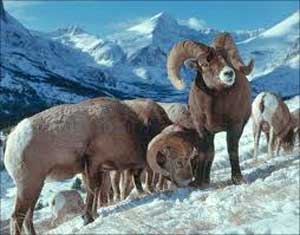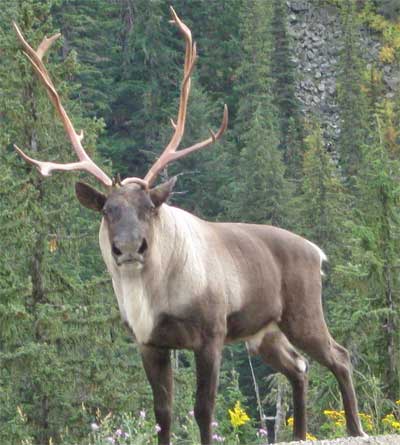Slow down for the bighorn
sheep
The stretch of highway between the small Montana communities
of Thompson Falls and Plains is known for the beautiful
vistas of the Clark Fork River and the surrounding mountains
and cliffs. The drive is also recognized for a resident
bighorn sheep herd that is frequently seen along Highway 200
east of the Thompson River. When visiting, please drive with
caution because the sheep are often near the roadway and
their numbers are declining.
 Bighorn
sheep (Ovis Canadensis) are native to the cliffs that
accompany
Bighorn
sheep (Ovis Canadensis) are native to the cliffs that
accompany
the highway east of Thompson Falls. The population was once
extirpated
from the area due to a disease borne from domestic sheep and
from
excessive hunting. Bighorn sheep were reintroduced to the
region in the
1950s and until recently have flourished. Predators are not
responsible for
the rapid demise of the species in the region, this one we
cant blame on
wolves and grizzly bears.
As traffic and speed have
increased over the years, a dangerous trend
began. Sometime in the mid 1980s, the bighorn sheep began to
die at an
ever-increasing rate in collisions with trucks and cars.
As recently as 2008 the
bighorn sheep population in the area numbered approximately
207 animals. Now as we enter 2013 only 50 sheep remain, a
precipitous decline. The numbers are staggering, in a single
15-mile stretch of highway over 400 bighorn sheep have been
killed in vehicular collisions since 1985, in a single year
36 died, a trucker from Butte killed 11 in one single
accident.
The sheep are attracted to the road surface and shoulder by
the deicer used by the Montana Department of Transportation
(MDOT). The sheep can be seen licking the salty compound
from the highway pavement. The bighorns move slowly and are
fearless which makes them very vulnerable to highway
collisions. A speeding 3,000 lb. vehicle with an inattentive
or irresponsible driver is lethal for a species that has no
innate fear or comprehension of traffic.
Bighorn sheep are very special creatures and they need our
help. Most of the collisions are avoidable because unlike
deer, the sheep do not cross the highway at night and rarely
make sudden moves into traffic. If we could get traffic to
slow and lure the herd back into the cliffs the recent
tragic trend could be reversed. Montana Fish Wildlife and
Parks have worked tirelessly to save the herd but
unfortunately the fate of the bighorn sheep is
in the hands of motorists and MDOT.
What you can do: Write the Montana Department of
Transportation (MDOT) and ask them to lower the speed limit
along the stretch of highway where bighorn sheep tend to
congregate. Also ask MDOT to find an alternative to the
magnesium chloride as a deicer.
The Plight of the Woodland
Caribou of northern Idaho
Caribou are beautiful, antler-bearing animals. They are the
only member of the family Cervidae in which both the male
and female of the species produce antlers, which they
periodically shed and re-grow. Their hooves balloon to the
size of dinner plates during the winter to help the caribou
walk on snow. They also use their hooves and antlers to dig
through snow to reach their main winter food source, lichen,
a plant that grows on rocks and tree bark.
 The
woodland caribou is a subspecies of caribou with habitat in
northern Idaho, eastern Washington, and southern British
Columbia. The number of woodland caribou remaining in the
wild continues to decline and is now facing a new threat
that is likely to extirpate them from the US. Woodland
caribou were once distributed across the northeastern,
northcentral, and northwestern contiguous United States.
More recently, caribou occupied habitat as far south as the
Salmon River in Idaho and as far to the east as the North
Fork of the Flathead River in Montana. By 1910, the species
only occupied the Selkirk, Cabinet, Purcell, and Bitterroot
Mountains. By the 1950's, caribou were reduced to about 100
animals in the Selkirk Mountains, with remnant bands in the
Cabinet and Yaak Mountains of Montana. By 1983 the only
population of woodland caribou remaining in the United
States was a small herd in the Selkirk Mountains of northern
Idaho and eastern Washington. The herd that occupied the
Cabinet Mountains was extirpated in the last half century.
The
woodland caribou is a subspecies of caribou with habitat in
northern Idaho, eastern Washington, and southern British
Columbia. The number of woodland caribou remaining in the
wild continues to decline and is now facing a new threat
that is likely to extirpate them from the US. Woodland
caribou were once distributed across the northeastern,
northcentral, and northwestern contiguous United States.
More recently, caribou occupied habitat as far south as the
Salmon River in Idaho and as far to the east as the North
Fork of the Flathead River in Montana. By 1910, the species
only occupied the Selkirk, Cabinet, Purcell, and Bitterroot
Mountains. By the 1950's, caribou were reduced to about 100
animals in the Selkirk Mountains, with remnant bands in the
Cabinet and Yaak Mountains of Montana. By 1983 the only
population of woodland caribou remaining in the United
States was a small herd in the Selkirk Mountains of northern
Idaho and eastern Washington. The herd that occupied the
Cabinet Mountains was extirpated in the last half century.
We often hear about species on the far side of the globe
that are on the brink of extinction because of human
expansion and ignorance. In 2013, because of habitat loss
and fragmentation, woodland caribou are close to extinction
in our own backyard. There are less than fifty woodland
caribou remaining in the U.S. Currently, the entire global
population occurs within British Columbia, Idaho, and
Washington.
In the U.S, woodland caribou were given emergency Endangered
Species Act protection in 1983 due to the declining
population and loss of habitat. North of the border, the
woodland caribou are provincially "red-listed" (considered
to be threatened or endangered) by British Columbia and
listed as threatened under Canada's Species at Risk Act
(SARA). Laws such as the Endangered Species Act were
designed to protect the threatened and endangered.
Unfortunately ESA has failed the woodland caribou.
On November 30, 2011, the US Fish and Wildlife Service in
response to the continued decline of the woodland caribou,
proposed to designate approximately 375,000 acres of
critical habitat for the species in the Selkirk Mountains.
This important action by the agency would have allowed the
woodland caribou to recover by providing the needed secure
habitat. One year later, on November 28, 2012, the US Fish
and Wildlife Service reduced the amount of critical habitat
from the original 375,000 acres to 30,000 acres. The
dramatic reduction in proposed protected habitat by the US
Fish and Wildlife Service was unfortunate for a species that
has already
lost the majority if its historic range. It is likely this
decision by the USFWS will be challenged in the courts.
Threats to the woodland caribou continue into 2013. The
estimated 46 woodland caribou in the Selkirk Mountains is
all that remain of the herds that once roamed from the
Pacific Northwest across the northern tier of states. Yet
this small herd of woodland caribou continues to be the
focus of those whose intent on the eradication of the
species.
Recently, Bonner County Idaho and the Idaho Snowmobile
Association petitioned the US Fish and Wildlife Service to
remove the woodland caribou from protections under the
Endangered Species Act. The Pacific Legal Foundation is
representing Bonner County and the Idaho Snowmobile
Association in this effort.
What you can do to help: If you are resident of Bonner
County Idaho, inform your County Commissioners that the
woodland caribou do make northern Idaho unique and
protections under ESA should remain. Contact the US Fish and
Wildlife Service and tell them that the small population of
woodland caribou needs to remain on the endangered species
list.

 Bighorn
sheep (Ovis Canadensis) are native to the cliffs that
accompany
Bighorn
sheep (Ovis Canadensis) are native to the cliffs that
accompany The
woodland caribou is a subspecies of caribou with habitat in
northern Idaho, eastern Washington, and southern British
Columbia. The number of woodland caribou remaining in the
wild continues to decline and is now facing a new threat
that is likely to extirpate them from the US. Woodland
caribou were once distributed across the northeastern,
northcentral, and northwestern contiguous United States.
More recently, caribou occupied habitat as far south as the
Salmon River in Idaho and as far to the east as the North
Fork of the Flathead River in Montana. By 1910, the species
only occupied the Selkirk, Cabinet, Purcell, and Bitterroot
Mountains. By the 1950's, caribou were reduced to about 100
animals in the Selkirk Mountains, with remnant bands in the
Cabinet and Yaak Mountains of Montana. By 1983 the only
population of woodland caribou remaining in the United
States was a small herd in the Selkirk Mountains of northern
Idaho and eastern Washington. The herd that occupied the
Cabinet Mountains was extirpated in the last half century.
The
woodland caribou is a subspecies of caribou with habitat in
northern Idaho, eastern Washington, and southern British
Columbia. The number of woodland caribou remaining in the
wild continues to decline and is now facing a new threat
that is likely to extirpate them from the US. Woodland
caribou were once distributed across the northeastern,
northcentral, and northwestern contiguous United States.
More recently, caribou occupied habitat as far south as the
Salmon River in Idaho and as far to the east as the North
Fork of the Flathead River in Montana. By 1910, the species
only occupied the Selkirk, Cabinet, Purcell, and Bitterroot
Mountains. By the 1950's, caribou were reduced to about 100
animals in the Selkirk Mountains, with remnant bands in the
Cabinet and Yaak Mountains of Montana. By 1983 the only
population of woodland caribou remaining in the United
States was a small herd in the Selkirk Mountains of northern
Idaho and eastern Washington. The herd that occupied the
Cabinet Mountains was extirpated in the last half century.